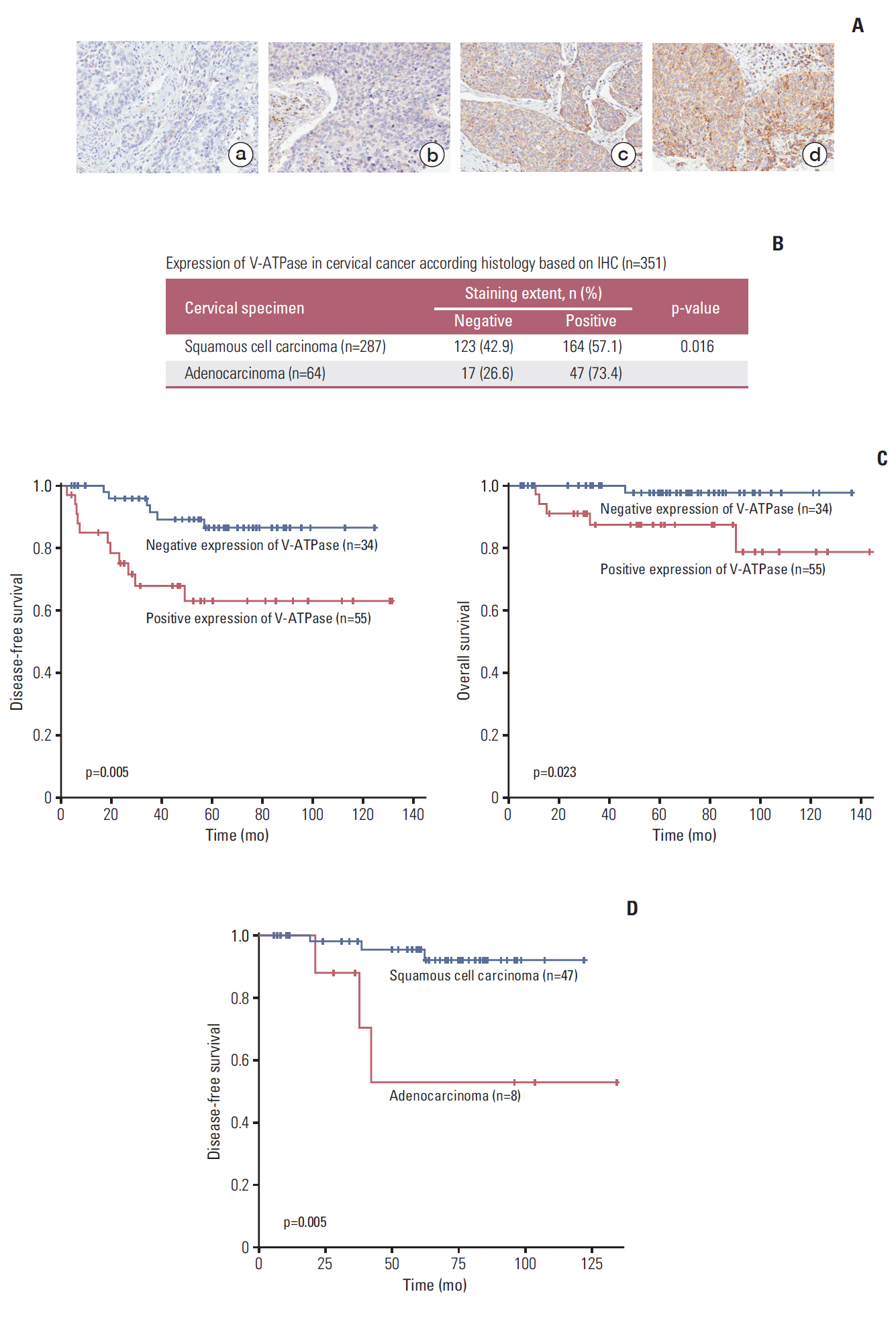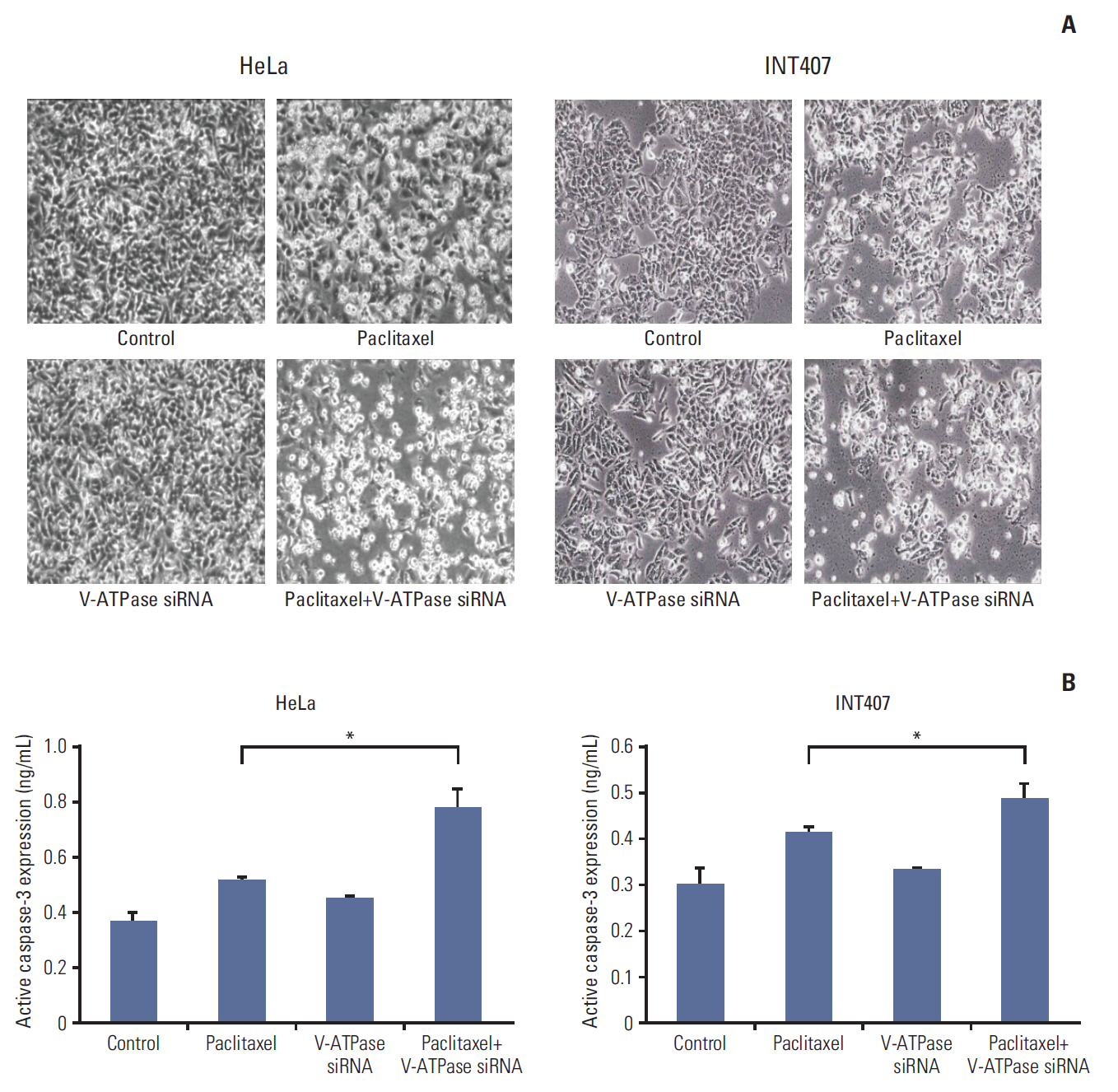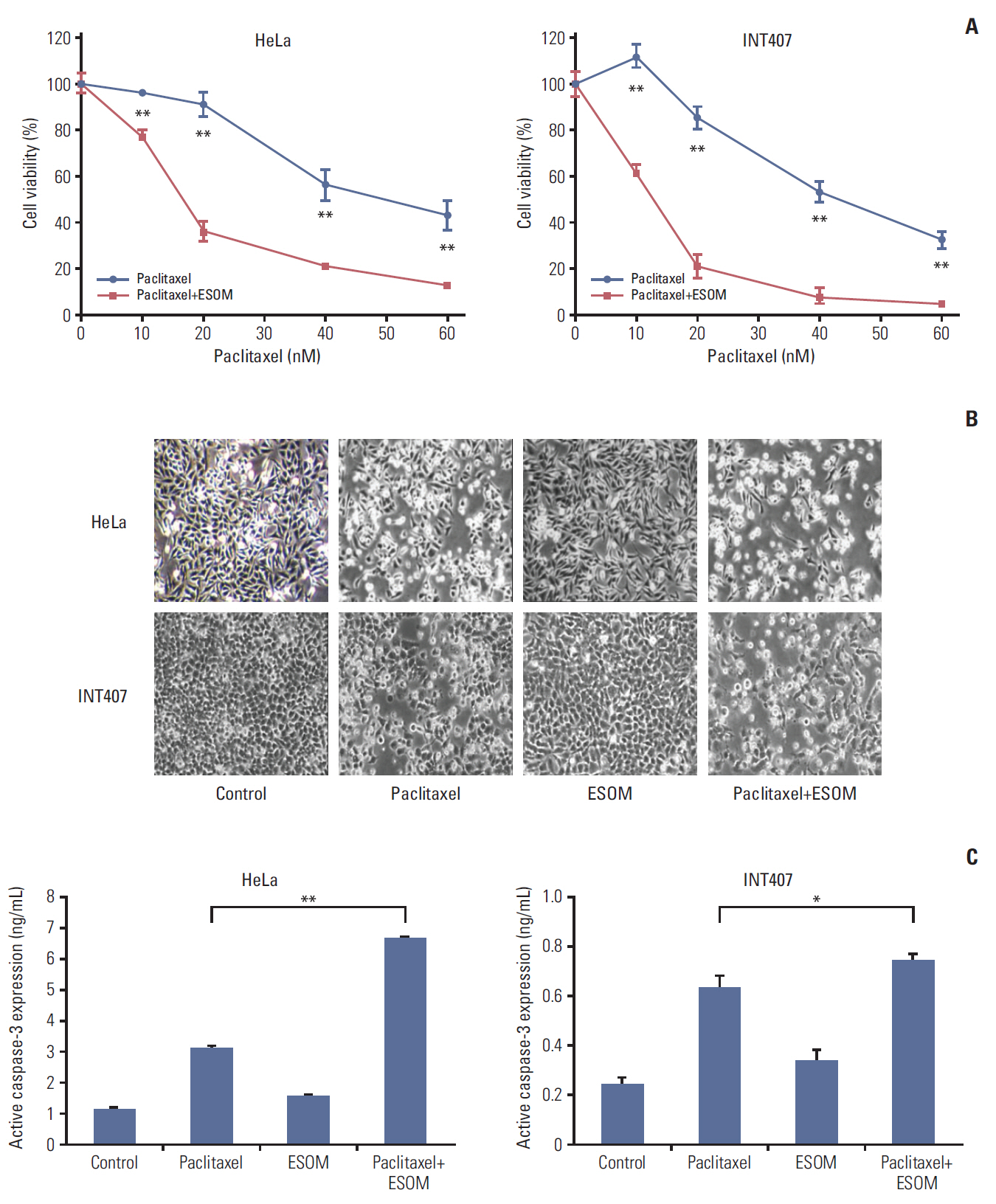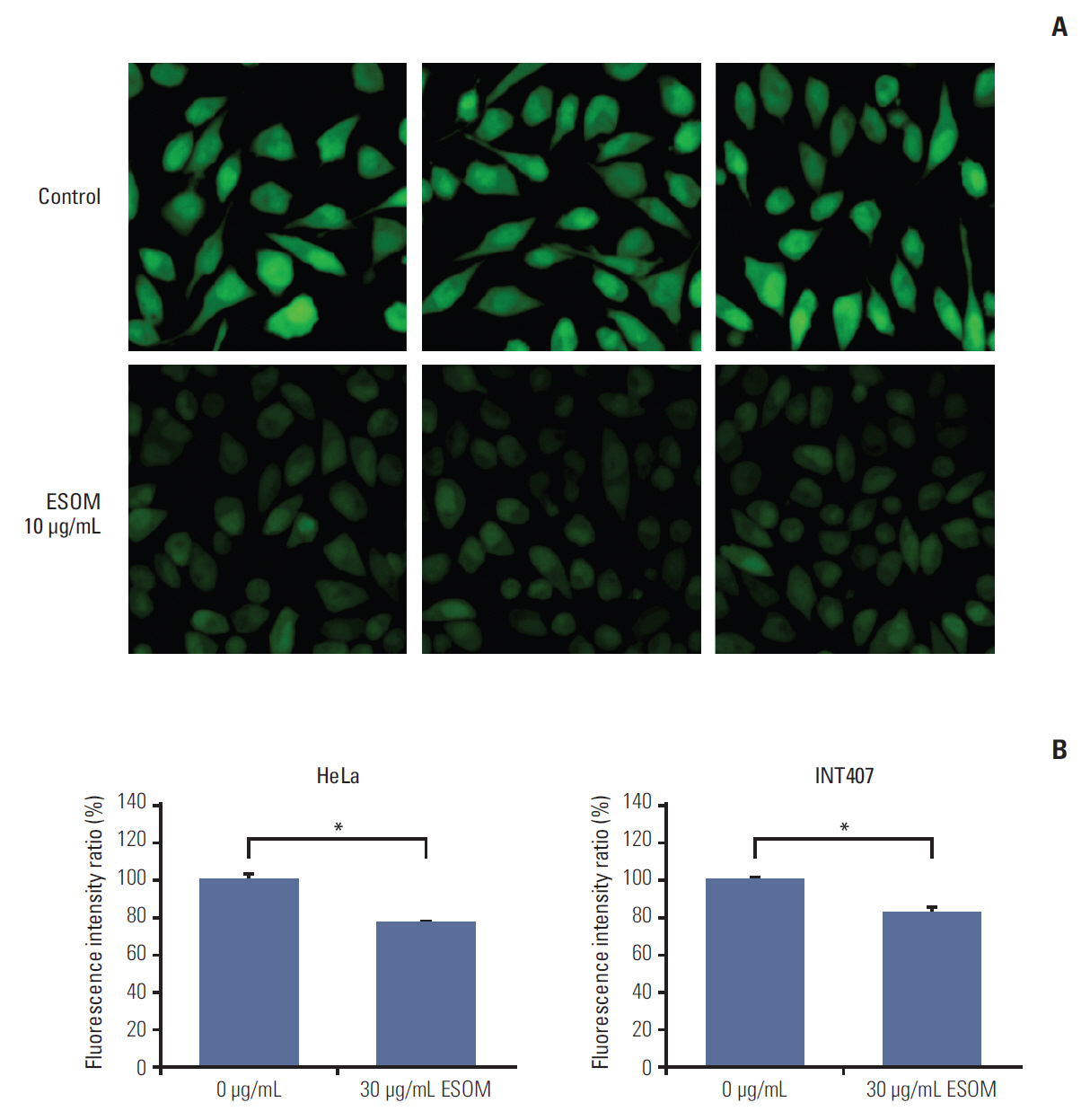Cancer Res Treat.
2017 Jul;49(3):595-606. 10.4143/crt.2016.034.
Proton Pump Inhibition Enhances the Cytotoxicity of Paclitaxel in Cervical Cancer
- Affiliations
-
- 1Department of Obstetrics and Gynecology, Kangbuk Samsung Hospital, Sungkyunkwan University School of Medicine, Seoul, Korea.
- 2Department of Obstetrics and Gynecology, Samsung Medical Center, Sungkyunkwan University School of Medicine, Seoul, Korea. garden.lee7@gmail.com, bgkim@skku.edu
- KMID: 2388305
- DOI: http://doi.org/10.4143/crt.2016.034
Abstract
- PURPOSE
This study was conducted to investigate whether a proton pump inhibitor (PPI) could enhance chemosensitivity via the inhibition of vacuolar-type H⺠ATPase (V-ATPase) in cervical cancer.
MATERIALS AND METHODS
The expression of V-ATPase was evaluated in 351 formalin-fixed, paraffin-embedded human cervical cancer tissues using immunohistochemistry and compared with clinicopathologic risk factors for disease prognosis. The influence of cell proliferation and apoptosis following V-ATPase siRNA transfection or esomeprazole pretreatment was assessed in cervical cancer cell lines using 3-(4,5-dimethylthiazol-2-yl)-2,5-diphenyl tetrazolium bromide and enzyme-linked immunosorbent assay, respectively.
RESULTS
Immunohistochemical analysis revealed that V-ATPase was expressed in about 60% of cervical cancer tissue samples (211/351), and the expression was predominantly found in adenocarcinoma histology (p=0.016). Among patients with initially bulky cervical cancer (n=89), those with V-ATPase expression had shorter disease-free survival (p=0.005) and overall survival (p=0.023). Co-treatment with V-ATPase siRNA or esomeprazole with paclitaxel significantly decreased the cell proliferation of cervical cancer cell lines, including HeLa and INT407, compared to cell lines treated with paclitaxel alone (p < 0.01). Moreover, V-ATPase siRNA or esomeprazole followed by paclitaxel significantly increased the expression of active caspase-3 in these cells compared to cells treated with paclitaxel alone (both, p < 0.05).
CONCLUSION
V-ATPase was predominantly expressed in cervical adenocarcinoma, and the expression of V-ATPases was associated with poor prognosis. The inhibition of V-ATPase via siRNA or PPI (esomeprazole) might enhance the chemosensitivity of paclitaxel in cervical cancer cells.
Keyword
MeSH Terms
-
Adenocarcinoma
Adenosine Triphosphatases
Antineoplastic Agents
Apoptosis
Caspase 3
Cell Line
Cell Proliferation
Disease-Free Survival
Enzyme-Linked Immunosorbent Assay
Esomeprazole
Humans
Immunohistochemistry
Paclitaxel*
Prognosis
Proton Pump Inhibitors
Proton Pumps*
Protons*
Risk Factors
RNA, Small Interfering
Transfection
Uterine Cervical Neoplasms*
Vacuolar Proton-Translocating ATPases
Adenosine Triphosphatases
Antineoplastic Agents
Caspase 3
Esomeprazole
Paclitaxel
Proton Pump Inhibitors
Proton Pumps
Protons
RNA, Small Interfering
Vacuolar Proton-Translocating ATPases
Figure
Reference
-
References
1. Ferlay J, Shin HR, Bray F, Forman D, Mathers C, Parkin DM. Estimates of worldwide burden of cancer in 2008: GLOBOCAN 2008. Int J Cancer. 2010; 127:2893–917.
Article2. Gien LT, Beauchemin MC, Thomas G. Adenocarcinoma: a unique cervical cancer. Gynecol Oncol. 2010; 116:140–6.
Article3. Lee YY, Choi CH, Kim TJ, Lee JW, Kim BG, Lee JH, et al. A comparison of pure adenocarcinoma and squamous cell carcinoma of the cervix after radical hysterectomy in stage IB-IIA. Gynecol Oncol. 2011; 120:439–43.
Article4. Peiretti M, Zapardiel I, Zanagnolo V, Landoni F, Morrow CP, Maggioni A. Management of recurrent cervical cancer: a review of the literature. Surg Oncol. 2012; 21:e59.
Article5. Nishi T, Forgac M. The vacuolar (H+)-ATPases: nature's most versatile proton pumps. Nat Rev Mol Cell Biol. 2002; 3:94–103.6. Martinez-Zaguilan R, Lynch RM, Martinez GM, Gillies RJ. Vacuolar-type H(+)-ATPases are functionally expressed in plasma membranes of human tumor cells. Am J Physiol. 1993; 265(4 Pt 1):C1015–29.
Article7. Mizunashi K, Furukawa Y, Katano K, Abe K. Effect of omeprazole, an inhibitor of H+,K(+)-ATPase, on bone resorption in humans. Calcif Tissue Int. 1993; 53:21–5.8. Sabolic I, Brown D, Verbavatz JM, Kleinman J. H(+)-ATPases of renal cortical and medullary endosomes are differentially sensitive to Sch-28080 and omeprazole. Am J Physiol. 1994; 266(6 Pt 2):F868–77.
Article9. Ha SY, Lee J, Jang J, Hong JY, Do IG, Park SH, et al. HER2-positive gastric cancer with concomitant MET and/or EGFR overexpression: a distinct subset of patients for dual inhibition therapy. Int J Cancer. 2015; 136:1629–35.
Article10. Huang L, Lu Q, Han Y, Li Z, Zhang Z, Li X. ABCG2/V-ATPase was associated with the drug resistance and tumor metastasis of esophageal squamous cancer cells. Diagn Pathol. 2012; 7:180.
Article11. Lu Q, Lu S, Huang L, Wang T, Wan Y, Zhou CX, et al. The expression of V-ATPase is associated with drug resistance and pathology of non-small-cell lung cancer. Diagn Pathol. 2013; 8:145.
Article12. De Milito A, Iessi E, Logozzi M, Lozupone F, Spada M, Marino ML, et al. Proton pump inhibitors induce apoptosis of human B-cell tumors through a caspase-independent mechanism involving reactive oxygen species. Cancer Res. 2007; 67:5408–17.
Article13. Luciani F, Spada M, De Milito A, Molinari A, Rivoltini L, Montinaro A, et al. Effect of proton pump inhibitor pretreatment on resistance of solid tumors to cytotoxic drugs. J Natl Cancer Inst. 2004; 96:1702–13.
Article14. Boyer MJ, Tannock IF. Regulation of intracellular pH in tumor cell lines: influence of microenvironmental conditions. Cancer Res. 1992; 52:4441–7.15. Zhdanov AV, Dmitriev RI, Papkovsky DB. Bafilomycin A1 activates respiration of neuronal cells via uncoupling associated with flickering depolarization of mitochondria. Cell Mol Life Sci. 2011; 68:903–17.
Article16. Lv C, Yang X, Yu B, Ma Q, Liu B, Liu Y. Blocking the Na+/H+ exchanger 1 with cariporide (HOE642) reduces the hypoxiainduced invasion of human tongue squamous cell carcinoma. Int J Oral Maxillofac Surg. 2012; 41:1206–10.17. Thomas GM. Improved treatment for cervical cancer: concurrent chemotherapy and radiotherapy. N Engl J Med. 1999; 340:1198–200.18. Robova H, Rob L, Halaska MJ, Pluta M, Skapa P, Strnad P, et al. High-dose density neoadjuvant chemotherapy in bulky IB cervical cancer. Gynecol Oncol. 2013; 128:49–53.
Article19. Yee GP, de Souza P, Khachigian LM. Current and potential treatments for cervical cancer. Curr Cancer Drug Targets. 2013; 13:205–20.20. Reshkin SJ, Greco MR, Cardone RA. Role of pHi, and proton transporters in oncogene-driven neoplastic transformation. Philos Trans R Soc Lond B Biol Sci. 2014; 369:20130100.21. Boedtkjer E, Bunch L, Pedersen SF. Physiology, pharmacology and pathophysiology of the pH regulatory transport proteins NHE1 and NBCn1: similarities, differences, and implications for cancer therapy. Curr Pharm Des. 2012; 18:1345–71.
Article22. Fais S, De Milito A, You H, Qin W. Targeting vacuolar H+-ATPases as a new strategy against cancer. Cancer Res. 2007; 67:10627–30.23. Larsson H, Mattson H, Sundell G, Carlsson E. Animal pharmacodynamics of omeprazole: a survey of its pharmacological properties in vivo. Scand J Gastroenterol Suppl. 1985; 108:23–35.24. Morimura T, Fujita K, Akita M, Nagashima M, Satomi A. The proton pump inhibitor inhibits cell growth and induces apoptosis in human hepatoblastoma. Pediatr Surg Int. 2008; 24:1087–94.
Article25. Yeo M, Kim DK, Kim YB, Oh TY, Lee JE, Cho SW, et al. Selective induction of apoptosis with proton pump inhibitor in gastric cancer cells. Clin Cancer Res. 2004; 10:8687–96.
Article26. Yamagata M, Tannock IF. The chronic administration of drugs that inhibit the regulation of intracellular pH: in vitro and antitumour effects. Br J Cancer. 1996; 73:1328–34.
Article27. Udelnow A, Kreyes A, Ellinger S, Landfester K, Walther P, Klapperstueck T, et al. Omeprazole inhibits proliferation and modulates autophagy in pancreatic cancer cells. PLoS One. 2011; 6:e20143.
Article28. Tredan O, Galmarini CM, Patel K, Tannock IF. Drug resistance and the solid tumor microenvironment. J Natl Cancer Inst. 2007; 99:1441–54.
Article29. Spugnini EP, Citro G, Fais S. Proton pump inhibitors as anti vacuolar-ATPases drugs: a novel anticancer strategy. J Exp Clin Cancer Res. 2010; 29:44.
Article30. De Milito A, Luciani F, Fais S. How to overcome cisplatin resistance through proton pump inhibitors. In : Bonetti A, Leone R, Muggia FM, Howell SB, editors. Platinum and other heavy metal compounds in cancer chemotherapy. New York: Springer;2009. p. 109–14.
- Full Text Links
- Actions
-
Cited
- CITED
-
- Close
- Share
- Similar articles
-
- Can proton pump inhibitors cause intestinal inflammation in children?
- Is hypomagnesemia associated with using proton pump inhibitors?
- Do Histamine-2 Receptor Antagonists and Proton Pump Inhibitors Really Have No Effect on the Gastric Emptying Rate?
- Can Proton Pump Inhibitors Increase Incidence of Nonsteroidal Anti-inflammatory Druginduced Small Bowel Injury?
- Can Nocturnal Acid-breakthrough Be Reduced by Long-acting Proton Pump Inhibitors?






